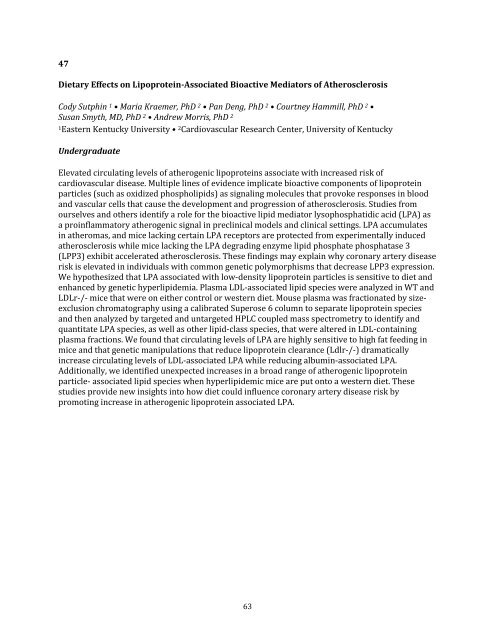2017 Cardiovascular Research Day Abstract Book
Create successful ePaper yourself
Turn your PDF publications into a flip-book with our unique Google optimized e-Paper software.
47<br />
Dietary Effects on Lipoprotein-Associated Bioactive Mediators of Atherosclerosis<br />
Cody Sutphin 1 • Maria Kraemer, PhD 2 • Pan Deng, PhD 2 • Courtney Hammill, PhD 2 •<br />
Susan Smyth, MD, PhD 2 • Andrew Morris, PhD 2<br />
1Eastern Kentucky University • 2 <strong>Cardiovascular</strong> <strong>Research</strong> Center, University of Kentucky<br />
Undergraduate<br />
Elevated circulating levels of atherogenic lipoproteins associate with increased risk of<br />
cardiovascular disease. Multiple lines of evidence implicate bioactive components of lipoprotein<br />
particles (such as oxidized phospholipids) as signaling molecules that provoke responses in blood<br />
and vascular cells that cause the development and progression of atherosclerosis. Studies from<br />
ourselves and others identify a role for the bioactive lipid mediator lysophosphatidic acid (LPA) as<br />
a proinflammatory atherogenic signal in preclinical models and clinical settings. LPA accumulates<br />
in atheromas, and mice lacking certain LPA receptors are protected from experimentally induced<br />
atherosclerosis while mice lacking the LPA degrading enzyme lipid phosphate phosphatase 3<br />
(LPP3) exhibit accelerated atherosclerosis. These findings may explain why coronary artery disease<br />
risk is elevated in individuals with common genetic polymorphisms that decrease LPP3 expression.<br />
We hypothesized that LPA associated with low-density lipoprotein particles is sensitive to diet and<br />
enhanced by genetic hyperlipidemia. Plasma LDL-associated lipid species were analyzed in WT and<br />
LDLr-/- mice that were on either control or western diet. Mouse plasma was fractionated by sizeexclusion<br />
chromatography using a calibrated Superose 6 column to separate lipoprotein species<br />
and then analyzed by targeted and untargeted HPLC coupled mass spectrometry to identify and<br />
quantitate LPA species, as well as other lipid-class species, that were altered in LDL-containing<br />
plasma fractions. We found that circulating levels of LPA are highly sensitive to high fat feeding in<br />
mice and that genetic manipulations that reduce lipoprotein clearance (Ldlr-/-) dramatically<br />
increase circulating levels of LDL-associated LPA while reducing albumin-associated LPA.<br />
Additionally, we identified unexpected increases in a broad range of atherogenic lipoprotein<br />
particle- associated lipid species when hyperlipidemic mice are put onto a western diet. These<br />
studies provide new insights into how diet could influence coronary artery disease risk by<br />
promoting increase in atherogenic lipoprotein associated LPA.<br />
63


